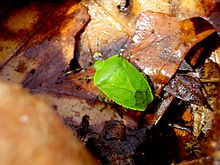Green Stink Bug
Acrosternum hilareSummary 7
The green stink bug or green soldier bug (Chinavia hilare) is a stink bug belonging to the family Pentatomidae.
Green stink bug 8
The green stink bug or green soldier bug (Chinavia hilaris) is a stink bug belonging to the family Pentatomidae.
It was historically placed in the genus Acrosternum, but according to Dr. David Rider of North Dakota State University and other experts, this placement is inaccurate; the genus name Acrosternum should be restricted to a handful of Old World, small, pale green species that live in dry arid areas, while the larger, brighter green species that live in both the Old and New Worlds should go by the genus name Chinavia, therefore this species is called Chinavia hilaris in more recent literature (e.g., Schwertner and Grazia, 2006).
Contents
Habitat[edit]
It is found in orchards, gardens, woodlands and crop fields throughout North America, feeding with their needle-like mouthparts on the juices of a wide variety of plants from May until the arrival of frost. Adults develop a preference for developing seeds and thus become crop pests (tomato, bean, pea, cotton, corn, soybean, eggplant). When no seeds are present, they also feed on stems and foliage, thus damaging several fruit trees, such as the apple, cherry, orange and peach trees.
Characteristics[edit]
Its color is typically bright green, with narrow yellow, orange, or reddish edges. It is a large, shield-shaped bug with an elongate, oval form and a length between 13–18 mm. It can be differentiated from the species Nezara viridula by its black outermost three antennal segments. Its anterolateral (= in front and away from the middle) pronotal margin is rather straight and not strongly arced such as in Acrosternum pennsylvanicum.
Both adults and nymphs have large stink glands on the underside of the thorax extending more than half-way to the edge of the metapleuron. They discharge large amounts of this foul-smelling liquid when disturbed. This liquid, dried and pulverized, was once used at industrial level to reinforce the smell of some acids. Now it's been replaced by artificial composits.
Reproduction[edit]
They attach their keg-shaped eggs on the underside of foliage in double rows of twelve eggs or more. The green stink bug produces one generation in the North and two generations in the South. The early instar nymphs are rather brightly colored and striped, turning green when approaching adulthood.
Pest management[edit]
It is parasitized by the tachinid fly Trichopoda pennipes.[1] The green stink bug uses the pheromone methyl (E,Z,Z)-2,4,6-decatrienoate in its communication system and this may be used to attract the bug away from crop fields.[2]
See also[edit]
Notes[edit]
- ^Susan Mahr. "Trichopoda pennipes". University of Wisconsin-Madison. Retrieved 2008-03-18.
- ^The Pherobase. "Semiochemical - me-E2Z4Z6-decatrienoate". Pest Management Information System. Retrieved 2008-03-18.
References[edit]
- Chinavia hilaris BugGuide. Iowa State University Entomology. Retrieved 6 October 2010.
- Lorus and Margery Milne : National Audubon Society : Field Guide to North American Insects and Spiders; Alfred A. Knopf, New York, fourteenth printing, 1996; ISBN 0-394-50763-0
- McPherson, J.E. (1982). The Pentatomoidea (Hemiptera) of Northeastern North America. Southern Illinois University Press. ISBN 0-8093-1040-6.
- Schwertner, C. F. and J. Grazia. 2006. Descrição de seis espécies de Chinavia (Hemiptera, Pentatomidae, Pentatominae) da América do Sul. Iheringia (Zool.) 96(2): 237-248.
Sources and Credits
- (c) Lisa Brown, some rights reserved (CC BY-NC), http://www.flickr.com/photos/33695431@N00/2173146065
- (c) Susan Ellis,, some rights reserved (CC BY), https://upload.wikimedia.org/wikipedia/commons/d/db/Acrosternum_hilare_1366044.jpg
- (c) Ilona Loser, some rights reserved (CC BY-SA), https://upload.wikimedia.org/wikipedia/commons/b/b8/Chinavia_hilaris.JPG
- (c) Picasa, some rights reserved (CC BY-NC), http://lh5.ggpht.com/-AuRhDWbyBt4/UBlBbFxziBI/AAAAAAAABJM/7gNoLAlsUs8/IMG_8174.JPG
- (c) Picasa, some rights reserved (CC BY-NC), http://lh5.ggpht.com/-v35OImlZ24g/UBlBcvhhfSI/AAAAAAAABJc/W7-NT9ZZwC4/IMG_8175.JPG
- (c) Terry Rosenmeier, some rights reserved (CC BY-NC), uploaded by Terry Rosenmeier
- (c) Wikipedia, some rights reserved (CC BY-SA), http://en.wikipedia.org/wiki/Acrosternum_hilare
- (c) Unknown, some rights reserved (CC BY-SA), http://eol.org/data_objects/30907464













